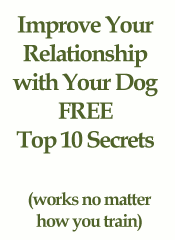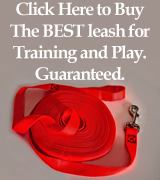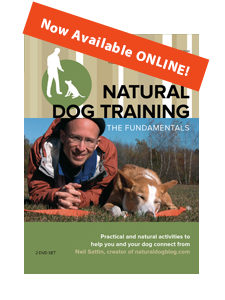When it comes to our dogs, probably the most important thing that anyone wants is to know that their dog will come when called no matter what distractions there are in the environment. It can be a matter of simple convenience - like calling your dog to come when you're ready to leave the dog park. Or it can be a matter of safety - calling your dog to come when you accidentally throw a ball too close to the road. In this article, I'm going to explain that there are several main destinations on the road to having a rock-solid recall - and by the end you will understand how to get to that ultimate goal of having your dog come when called no matter what.
What does "no matter what" mean?
Most dogs will come when called if there's nothing better to do. You're hanging out in the kitchen, decide to fix a snack for yourself, wonder where your dog is, call out, and your dog comes running. "See - my dog knows how to come when called!" Not so fast...what's more likely is that your dog has learned that when they hear "Sparky, come!" they should immediately pursue the most attractive thing in their environment (which we discussed in this article on why your dog stopped coming when called). In a quiet house, with you rustling in the kitchen, guess what the most interesting thing in your dog's environment is? You! Well...you and whatever you've just pulled out of the fridge.
On the other hand, what would your dog do if you were out in the world? If you accidentally dropped the leash and your dog started running towards their favorite thingy on the other side of the road? If you were walking through the woods and your dog suddenly picked up the scent of, and started chasing after, a deer? Now we're getting closer to "no matter what". Your dog's recall needs to be completely reliable even in the MOST tempting of circumstances, and when the chase has already begun.
What's so difficult about those tempting circumstances?
Generally, if you have tapped into your dog's emotional energy circuits and learned how to attract them when they're in a high state of prey drive (using pushing, tug, and redirection), then you will be able to call your dog to you, even when they're tempted by something, as long as they have not fully committed to pursuing the object of their attraction. You notice the deer in the field before your dog does, and you immediately start playing tug with your dog. Your dog takes a few steps towards the squirrel, but you call "Ready!" - and your dog flies back to your side for some pushing. In these situations your dog feels energized and is looking for a way to offload that energy "in the flow". But your dog isn't in the flow yet - at least not completely. So you have a chance, in those moments, to simply say "Hey, here I am - the best way to resolve that energy!"
However, once your dog has committed to connecting with the thing that they desire and is in the flow of that commitment, things get more challenging. Somehow your dog has to learn how to switch objectives in this situation. Since it feels good to be "in the flow", then if your dog perceives the switch (i.e. coming when you call) as an interruption of flow, then there is almost no way that your dog will make that switch. It just feels too "bad" in relation to just staying in the flow, in pursuit of connecting with the object of desire. You need to show your dog that even in this situation they can stay completely in the flow AND come back to you.
The Steps to a Rock-Solid Recall
[note - In my DVD set, Natural Dog Training: The Fundamentals, the entirety of DVD #2 is devoted to "Mastering Obedience". It lays the groundwork by teaching your dog all of the basic obedience exercises in a high state of drive (sit/down/stay/heel), and then takes you step-by-step through the process that I'm about to detail for developing a rock-solid recall with your dog. If a picture is worth a thousand words, then video is probably worth a million - especially when you're trying to do more advanced training. Over time I will be able to detail these steps here on the Naturaldogblog - for now, hopefully this is enough to give you a sense of where you want to go, and how you'll get there.]
The process of dog training that I teach starts and ends with the recall. The very first things that you do, pushing, and playing tug-of-war, change the dynamic between you and your dog, so your dog learns that they can be safe with you at higher and higher levels of energy. Then, with redirection, you can resolve the feelings of attraction that your dog experiences when encountering other enticing things "out there" in the world. The ONLY way that your dog is going to be able to come back to you full-tilt instead of pursuing something else when they're locked on target is if you have shown given your dog a way to feel connected to the flow, with you, at high levels of emotional intensity. It's the only way that you have a chance of being as compelling as whatever it is that has your dog's full attention.
Once that attraction is in place, here is how you will use it to get to the place where your dog will come when called no matter what:
- Focused, Attentive Down/Stay in High Drive - First things first - you teach your dog that they can still feel energized and in-the-flow even when stationary. This isn't a reluctant "ho-hum I guess I'll lie down" sort of down/stay, this is the kind of down where your dog hits the dirt, stays energized, and is completely focused on you. I teach how to get to this place with your dog in this article on teaching the down and this article on teaching the stay.
- Heeling - By learning how to heel next to you, your dog is actually learning how to be in-the-flow and totally in synch with your movements. Heeling deepens the groove of the emotional connection between the two of you, and also prepares you for the next important step - which links heeling with an energized down.
- The Running Down - This step teaches your dog the transition between being in-the-flow and in motion (heeling next to you) and being in-the-flow and stationary (the down/stay). In brief, you have your dog heeling next to you, quicken your pace, say "Ready!" (to prep your dog that something is coming), and then, sharply, "Down!". This "down" should be one of those "your life depends on it" kind of deliveries. Your dog will hit the dirt, and immediately you transition into praise, food (to feed the down position), and the "stay" part of your down/stay routine. You don't want to overdo this exercise in any one session - just a few times, at most - and then some uninhibited running, pushing, and heeling to work out any stress that the exercise might have caused.
- Down at a Distance - In this exercise, you teach your dog how to hit the dirt, energized, while they move away from you enticed by something (I usually use a tug toy). You start with very small distances, and then progress to larger and larger distances. You are teaching your dog how to be running, in-the-flow, in pursuit of something else, and to come to a complete stop. Importantly, your dog learns how to stay in the flow while doing it. In other words, even though your dog is hitting the dirt instead of pursuing that thing, it still feels good. You can release your dog to get the toy - or, even better, have your dog stay while you pick up the original toy and then release your dog from the stay with some tugging or pushing.
- Redirect Down at a Distance - This step is a modification of the exercise above. You send your dog off in pursuit of a toy and have them lie down at a distance from you. THEN you release your dog from the down/stay by calling your dog back to you, either to play tug with another, identical tug toy - or for some pushing. Since your dog is in a down/stay, and energized, and focused on you, this release is very easy for them to accomplish. To your dog it feels like "Pursue - in the flow. Down/stay - in the flow. Come back to my person for some pushing/tug - in the flow." You see - the whole sequence is in the flow.
At this point, you have taught your dog how to be completely energized in pursuit of something else, stop in their tracks, and come back to you - all in the flow. It's important to break it down step-by-step like that for your dog, so that they can successfully get each part of the sequence, and get each part of the sequence solidly before moving on to the next, final step (which I generally do with a really enticing tug toy - to keep the circumstances as controlled as possible before moving out into the real world with this exercise).
- Throw a toy for your dog, then call "Ready, Sparky!", and celebrate as your dog turns in mid-run, circles back around to you, and connects with you for some tug, chase, and pushing.
You're at the final step. Your dog is in the flow and changing direction mid-run to come back to you. Some dogs will spin on a dime, other dogs will make a wide arc as they divert from the original path and circle around back to you. It's vitally important that you make the return a huge celebration of push, tug, chase - by stepping up your mooseness and ensuring that your dog stays in the flow and resolves huge amounts of energy and stress, you are cementing your place as the best, most attractive being in your dog's universe.
Use the recall sparingly
Let's say you were in the living room, reading a book. And your spouse/partner was a few rooms away in the kitchen. And your significant other called out, excitedly "Hey, could you come here?" What would you do? You'd probably get right up to see what it was about, right?
Now let's say you get to the kitchen and ask "What's up, honey?" And your partner says, "Oh, nothing, I was just trying to see if you'd come". How many times would YOU respond to "Hey, could you come here?" if there was nothing great or important at the other end? Probably not many. And in general, wouldn't it make you a lot less likely to respond to your partner's call?
If you want to reinforce the work that you're doing with your dog so that you have obedience in the moments when it matters most, then save your obedience for the moments when it matters most! That and specific times when you're practicing and set up to give your dog huge moosey payoffs for doing what you want your dog to do. As I've mentioned many times, my goal with a dog is not to produce a dog-tomaton that responds robotically in lock-step with me 24-7. My goal is to help a dog and an owner come into synch with each other, so that an owner learns how to evoke their dog's most social (and non-problematic) nature, and so that commands like "down", "stay", "heel", and "come!" are 100% reliable in the times when it really counts. If you're looking for a doggy robot, then you probably ought to talk to the folks at MIT. On the other hand, if you're looking for a more fulfilling relationship with your dog, then you'll create a structure in your life so that your dog can be a dog - and know that when you ask something that isn't necessarily coming naturally, it's because it's really important. So don't wear out your obedience with overuse. Keep it fresh and intense for both you and your dog.
As I said at the beginning, having a dog who'll come back no matter what is one of the main goals of dog training. It allows you to "let your dog be a dog" - all the while knowing that you can keep your dog out of harm's way when it's truly important. I wanted to show you that there are many steps in the process of having a dog come when called no matter what. However, if you follow the steps as I've outlined them above, you will definitely achieve your objective. Just take your time and enjoy the process of getting there!
Please join the conversation about this article over in the Naturaldogblog Forum.





Great Article! 🙂
Much of it is so very familiar to me -
I honestly cannot say how much i always, always, always stress with the owners "use it sparingly", not to mention that i use that "spouse" example all the time! sadly though, it falls on deaf ears often, and they are left wondering why their dog won't listen and is totally uninterested in them.
(an additional thing i add, at least in the early training, is telling them to keep moving! i find owners stand still far too often, and basically, turn into a piece of scenery - def not very prey like)
Hi Jamie,
Good point on the "keep moving" - creating more incentive for a dog to chase you on the return is definitely very helpful.
As I've mentioned elsewhere (and will be mentioning more) - I feel that one of the most important things a dog trainer can do is to help their clients overcome the habits of theirs that create their doggie's habits. Funny that the "spouse example" ends up falling on deaf ears - probably just another example of how important it is to ensure a person is motivated from within when working with their dog (as opposed to the "just fix the dog" approach).
Thanks for commenting!